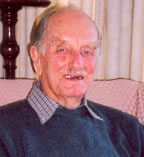Royal Air Force Spitfire pilot, Philip Stewart, from Whanganui, describes how he went about destroying enemy trains and other vehicles.
Transcript
Well you attacked them until they blew up.
And so they literally blew up?
Literally blew up, yes. They would stop and then you wouldn’t be content with that of course, you would make absolutely certain that they weren’t going to get mobile again. You’d see large lumps flying off them, that sort of thing. Sometimes they might explode to some extent.
How much skill did it take to control not only flying but shooting, when you were going in for a specific moving target like that?
Well a fair amount. You, of course, had your gun sights which were the most important thing, but also we’d been very much trained. We did a lot, a lot of gun practice. At times when we weren’t busy on operations, we used to go out to shooting ranges on the coast. So we usually with the shingle banks and things like that, at Portsmouth particularly there was one. There were targets set up and we did a lot of gunnery practice, if you like, shooting at them with both cannon or machine gun. So it was a skill that you learnt from practice.

Royal Air Force Spitfire pilot, Philip Stewart.

Philip Stewart in 2004

Community contributions